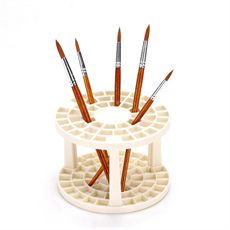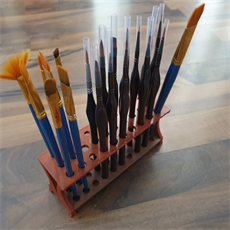When painting landscapes, the choice of brushes is crucial to capture the various elements and textures found in nature. Landscapes often require a wide range of brush types to depict everything from skies and mountains to trees and water. Here are some essential brushes for painting landscapes:
- Flat Brushes: These brushes have a square or rectangular shape with straight edges. They are versatile for covering large areas, such as the sky or ground.
- Round Brushes: Round brushes have a pointed tip and are useful for creating fine details like branches, rocks, or small foliage.
- Filbert Brushes: Filbert brushes have a flat, oval-shaped tip that can be used for blending and softening edges, which is great for creating the appearance of distant hills or clouds.
- Fan Brushes: Fan brushes are excellent for creating soft, textured effects in foliage, grass, or clouds. They can also be used for blending and adding subtle details.
- Liner Brushes: Liner brushes have long, thin bristles, ideal for creating fine lines and delicate details such as tree branches, twigs, or small, intricate elements.
- Palette Knives: While not brushes, palette knives are essential for applying thick impasto textures, mixing colors, and creating various knife techniques for mountains, rocks, and other textured surfaces.
- Rigger Brushes: Also known as script liners, rigger brushes have long, fine bristles that hold a lot of paint. They are perfect for creating long, flowing lines like rivers, streams, or reeds.
- Angled Brushes: Angled brushes have bristles cut at an angle and are useful for painting grassy slopes, hillsides, or any elements with angular shapes.
- Mop Brushes: Mop brushes have soft, rounded tips and are great for blending and softening edges in skies, clouds, or water reflections.
- Sponge Brushes: Natural or synthetic sponge brushes can be used to create texture in foliage, rocks, or even for stippling effects in the landscape.
- Bristle Brushes: Stiff bristle brushes, often made from hog hair, are excellent for creating textured effects in grass, trees, and other rugged terrain.
- Detail Brushes: These are tiny brushes with fine tips for adding minute details like leaves, flowers, and other small elements in the landscape.
- Hake Brushes: Hake brushes are flat, wide brushes with soft bristles and are particularly useful for applying large washes or soft blending in skies and backgrounds.
- Dagger Brushes: Dagger brushes have a unique shape with a pointed tip and a flat, angled edge. They are versatile for creating a variety of strokes and shapes, making them suitable for trees, grasses, and other landscape features.
Remember that the specific brushes you need may vary depending on the style of landscape you’re painting and the techniques you prefer. Experiment with different brushes to discover which ones work best for your particular landscape painting style and vision.












